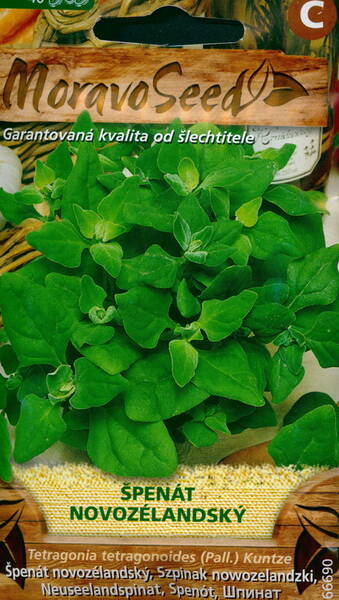Your shopping cart is empty!
New Zealand Spinach
New Zealand spinach (Tetragonia expansa) is a cold hardy, creeping perennial that is grown as an annual in our climate.
It has thick leaves about 5 cm long and long shoots reaching 90-120 cm.
It grows best in open areas, on fairly fertile, moisture-retaining soil with average nitrogen content.
In a temperate climate, seeds are sown indoors, seedlings are planted in open ground at a distance of 45 cm from one another.
Or, seeds are sown in open ground "in situ", after frost has passed, gradually thinning to the required rate.
Plantings of young plants are regularly weeded from weeds (adults cover the soil and suppress the growth of weeds themselves).
Spinach seeds are slow growing and require pre-soaking and sprouting. To stimulate germination, seeds are recommended to be soaked for 24 hours before sowing.
Seedlings appear two weeks after sowing. It is advisable to sow germinated seeds immediately in a pot with a diameter of 7-8 cm, 3-4 pcs. in each.
Sowing is carried out in March-April, in cold greenhouses on solar heating - a little later. When sowing in boxes, the picking of plants is carried out in the phase of one or two leaves.
Seedlings are planted in open ground at the age of 40-50 days, in late May-early June, when frosts have passed.
In a row, plants are placed every 40-50 cm or according to the scheme 70x40, 80x50, 100x100 cm or in the "square-nested way" - 50x50 cm.
New Zealand spinach grows slowly in the initial period, so the bed is used for co-cultivation with fast-maturing vegetable crops
(head lettuce, radish or regular spinach).
New Zealand spinach is suitable for planting in beds with any other crops that require a large number of nutrients.
For example cabbage, celery and fennel. However, over time, New Zealand spinach grows very large, so it should not be planted close to other vegetables.
Leaves and shoot tips can be harvested six to seven weeks after sowing.
Frequent pinching stimulates the growth of young leaves for three to four months.
1,0 g = 15 seeds.
It has thick leaves about 5 cm long and long shoots reaching 90-120 cm.
It grows best in open areas, on fairly fertile, moisture-retaining soil with average nitrogen content.
In a temperate climate, seeds are sown indoors, seedlings are planted in open ground at a distance of 45 cm from one another.
Or, seeds are sown in open ground "in situ", after frost has passed, gradually thinning to the required rate.
Plantings of young plants are regularly weeded from weeds (adults cover the soil and suppress the growth of weeds themselves).
Spinach seeds are slow growing and require pre-soaking and sprouting. To stimulate germination, seeds are recommended to be soaked for 24 hours before sowing.
Seedlings appear two weeks after sowing. It is advisable to sow germinated seeds immediately in a pot with a diameter of 7-8 cm, 3-4 pcs. in each.
Sowing is carried out in March-April, in cold greenhouses on solar heating - a little later. When sowing in boxes, the picking of plants is carried out in the phase of one or two leaves.
Seedlings are planted in open ground at the age of 40-50 days, in late May-early June, when frosts have passed.
In a row, plants are placed every 40-50 cm or according to the scheme 70x40, 80x50, 100x100 cm or in the "square-nested way" - 50x50 cm.
New Zealand spinach grows slowly in the initial period, so the bed is used for co-cultivation with fast-maturing vegetable crops
(head lettuce, radish or regular spinach).
New Zealand spinach is suitable for planting in beds with any other crops that require a large number of nutrients.
For example cabbage, celery and fennel. However, over time, New Zealand spinach grows very large, so it should not be planted close to other vegetables.
Leaves and shoot tips can be harvested six to seven weeks after sowing.
Frequent pinching stimulates the growth of young leaves for three to four months.
1,0 g = 15 seeds.
Eng.: New Zealand Spinach. Suom.: Lamopinaatti, uudenseelanninpinaatti. Sven.: Nyzeeländsk Spenat. Bot. syn.: Demidovia tetragonoides Pall., Tetragonia expansa.












